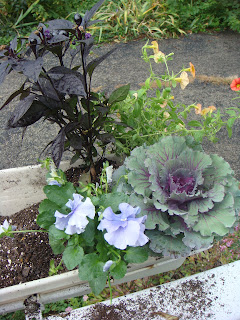Excuse me as I drag out my soapbox...
If there is one thing that really fries my bananas, it's construction damage and death to trees. I can live with people planting them in the wrong place, pruning them into meatballs, and spraying them with chemicals so they don't fruit. However, killing a tree with blatant ignorance just puts my knickers in a twist. Not only are you killing a mature, beautiful tree that offers many benefits, you incur thousands of dollars in expense to have it removed.
Example #1:
The two shingle oaks on the right will not be long for this world. Sure, it'll be a handful of years before they kick the bucket, but they will eventually succumb. Why? Oaks do NOT like their roots messed with, especially mature trees. This is a beautiful home. Yet, the construction crews have pounded the soil into concrete with heavy machinery, stacking of bricks and placing of dumpsters. It's hard to see, but the trees are already showing signs of stress and the drought isn't helping. In three or four years, these poor homeowners will have quite the bill from the tree removal company. In the meantime, I have to drive by this everyday and not start frothing at the mouth.
Example #2:
This just breaks my heart. This stately 100 plus year-old American elm managed to survive Dutch elm disease, storms and old age until these people added on to the house. This is around the corner from my parents' house. It has taken three years for this tree to die. I watched the construction from day one. No tree protection, no fencing, no mulch, nothing. Usually an elm is a pretty tough customer, but there's only so much abuse it can handle. It lost about a quarter to one-third of its root system, and again, the drought this year didn't help. Now, deader than a doornail. I don't even want to think about how much removal is going to run them since it is not easily accessible.
The lesson is this: if you value your trees and are building a house, putting on an addition or creating a patio or deck, please, please please put some thought into your mature trees. Tree roots extend one to two times outside the length of the dripline. The fine feeder roots necessary for food and water are in the top 12 to 18 inches of the soil. Fence off the root zones at least to the dripline. Mulch heavily those root protection zones and areas of vehicle traffic. Water during dry periods. Prune the crown to compensate for stress. Don't fertilize so it doesn't incur further stress. Be vilgilant with your contractors and crews. Work fines into the contract. Consider hiring a consulting arborist.
It's worth it to save a tree if only in the reduced air conditioning costs!































